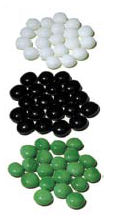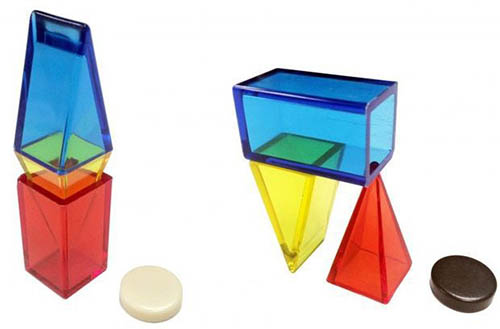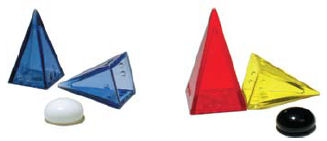
The following terms and definitions can make it easier for Masters and students to conceptualize and discuss rules.
Color

The standard Zendo colors are red, yellow, green, and blue, though other pyramid colors can be added or substituted. A koan "contains a color" if it contains any pieces of that color. A rule will occasionally refer to the "number of colors" contained within a koan, or within a subset of its pieces.
Size
There are three sizes of pieces: small, medium, and large. A koan "contains a size" if it contains any pieces of that size. As with color, a rule will occasionally refer to the "number of sizes" found within a koan, or within a subset of its pieces. Unlike color, sizes are related to each other in specific ways, such as "larger", "smaller", "largest", and "smallest".
A koan always contains a "largest size", and all of the pieces of that size are referred to as "the largest pieces in the koan"; similarly, a koan always contains a smallest size, and all of those pieces are referred to as the smallest pieces in the koan. If a koan contains exactly one size, those pieces are both the largest and the smallest pieces in the koan.
Pip Count
Each piece is marked with "pips" to indicate its size-one pip for a small piece, two for a medium piece, and three for a large piece. This number represents a piece's "value" or "pip-count". A group of pieces has a pip-count equal to the values of all its pieces added together. A rule may refer to the pip-count of an entire koan, or any subset of pieces within a koan.
For instance, a rule might refer to the pip-count of all of a koan's red pieces, or even the pip-count of all red pieces that are touching the table and pointing at blue pieces. Note that when a koan contains no red pieces, the pip-count of red in that koan is zero. When employing the concepts of "odd" and "even", don't forget that zero is an even number!
Orientation (upright/flat/weird)
Each piece within a koan exists in one of three "orientations": "upright'; "flat", or "weird". A piece is upright when it's pointing straight upward, with its base parallel to the table, either on it or above it. A piece is flat when its lowest triangular side is parallel to the table, either on it or above it. A piece is "weird" if it's neither upright nor flat.
Note that these three orientations are mutually exclusive-a piece cannot be both flat and weird at the same time. Also note that a piece's orientation has nothing to do with whether or not that piece is touching the playing surface-a piece which is lying nested inside another piece or lying across the tips of upright pieces is still flat.
Finally, note that a group of pieces has the same "orientation" as long as they're all upright, all flat, or all weird, even if they're not all pointing in the same direction.
Grounded And Ungrounded
A piece is "grounded" if any part of it is touching the playing surface; otherwise it's "ungrounded". Note that this attribute is entirely independent of a piece's "orientation".
Direction
This term is used slightly differently than "orientation"; it refers to the direction that pieces are pointing relative to each other. Although absolute direction is not allowed, multiple pieces may be said to be pointing in the "same direction', or "different directions', or perhaps even "opposite directions".
Pointing
Every piece has an imaginary "pointing ray" that shoots directly out of its tip and extends outward into space. The pointing ray will pass unhindered through any other piece; however, if the ray hits the table, the ray will bend to skim along the table's surface.
A piece is "pointing at" all of the pieces its pointing ray touches. A piece may be referred to as "the first piece being pointed at', or "the second piece being pointed at", and so on. A piece may "point through' one or more pieces at some other piece.
Touching
If two pieces are making physical contact in any way, they're touching. Unlike pointing, if one piece is touching another piece, the other piece is always touching it back.
Tower/stack
A tower or stack is any connected group of one or more pieces in which the tip of each piece is fully touching the underside of the tip of the piece above it. A tower may be upright, flat, or weird. Pieces are still said to be "above' other pieces in a tower, even if the tower is lying on its side. The pieces within a tower do not form sub-towers-a three-piece tower does not contain two two-piece towers within it. Single pieces are also referred to as towers. It follows that every piece in a koan belongs to exactly one tower.
Height
The physically highest point of a piece marks the vertical position of that piece within the koan. A piece may be higher than, lower than, or at the same height as any other piece in the koan. There will always be at least one highest piece and at least one lowest piece in a koan. It's possible for the same pieces to be both the highest and the lowest in a koan.
Exactly/at Least
Avoid using indefinite statements like "contains a red piece', or "contains two upright pieces', because it's not clear whether you mean exactly that number, or at least that number. Always use definite statements like "contains exactly one red piece', or "contains at least two upright pieces'.
Majority/plurality:
When there are more red pieces in a koan than any other color, the koan contains a "plurality' of red pieces. When there are more red pieces in a koan than all the other colors put together, the koan contains a "majority' of red pieces.
Many people use the word "majority' when they mean "plurality'. If players use either of these terms while you are the Master, ask for clarification.

How To Use These Definitions
The purpose of the Terminology list is twofold: to provide a way for players to conceptualize rules, and to provide a common language to aid the communication process between Masters and students.
For the student, formulating and communicating a guess is one of the most difficult aspects of the game. For the Master, understanding and probing that guess is just as difficult. Standard terminology makes this process easier for both parties.
Some Masters worry that the adoption of this standard terminology will restrict their options when creating new rules, but it's important to understand that these definitions are not restrictive in any way. If you want to make a rule in which upright pieces do not point at pieces which are above them, you don't need to redefine pointing.
Simply specify in your rule that only non-upright pointing pieces matter. If you want to make a rule in which pieces can't "point through" other pieces, simply specify in the rule that only the first piece being pointed at matters. If you want to use a totally new concept that isn't included in this list at all, feel free to do so.
For instance, you're perfectly free to create a rule that involves the concept of "pointing with the corner of a piece", even though that style of pointing is not defined at all on this page. The definitions given here only define the most common concepts, which are used over and over again by many different rules.
Since these standard definitions are merely conventions, and since there are concepts like "pointing with a corner" that have no standard definitions, as the Master you must always make sure that you understand a student's terms. When a student guesses a rule, you are obliged to interpret that guess based on the student's terminology, not your own.
Therefore, unless you already know that you and the student share a common language, you should always ask the student to clarify terms, even basic ones like "pointing". The students are free to ask you about your own terminology as well; you are not obliged to answer, but you are free to discuss standards of terminology that might make communication easier.
The Structure of a Rule
The easiest way to state any rule is to use one of the two following forms:
- A koan has the Buddha-nature if (and only if) X.
- A koan does not have the Buddha-nature if (and only if) X.
By convention, the phrase "and only if" is usually omitted. If a rule explicitly states that certain koans have the Buddha-nature, you may assume that the rest of the koans do not; if a rule explicitly states that certain koans do not have the Buddha-nature, you may assume that the rest of the koans do.

Some Problem Cases
Even if all of the players have agreed upon standard definitions and terminology, pitfalls and problems can arise. Consider the following:
- "A koan has the Buddha-nature if all of its red pieces are upright". What if a koan contains no red pieces?
- "A koan has the Buddha-nature if all of its pieces are pointing in the same direction". What if a koan only contains one piece?
- "A koan has the Buddha-nature if its largest piece is green". What if a koan contains more than one largest piece?
There are three basic approaches to these conundrums. I call the first the "natural language" approach. According to this approach, these statements all imply that the referent must exist in order for the koan to follow the rule.
For instance, the rule "a koan has the Buddha-nature if all of its red pieces are upright" implies that there must be at least one red piece, so a koan with no red pieces at all would be marked black. The rule "a koan has the Buddha-nature if all of its pieces are pointing in the same direction" implies that there must be at least two pieces, so a koan with only one piece would be marked black.
The rule "a koan has the Buddha-nature if its largest piece is green" implies that there must be exactly one largest piece, so a koan with two largest pieces would be marked black.
I call the second approach the "western logic" approach. According to this approach, these rules should be trans- lated into unambiguous logical equivalents. For instance, the rule "a koan has the Buddha-nature if all of its red pieces are upright" can be translated into the rule "a koan does not have the Buddha-nature if it contains a non-upright red piece", so a koan with no red pieces at all would be marked white.
The rule "a koan has the Buddha- nature if all of its pieces are pointing in the same direction" can be translated into "a koan does not have the Buddha- nature if it contains two pieces pointing in different directions", so a koan with only one piece would be marked white.
The rule "a koan has the Buddha-nature if its largest piece is green" can be translated into "a koan has the Buddha-nature if it contains a piece such that there is no larger piece in the koan, it is the only such piece, and it is green", so a koan with two largest pieces would be marked black. (This is actually the same result that we saw in the natural language approach).
I call the third approach the "mu" approach. It makes use of the Zen concept of "mu", which means something like "unask the question". According to this approach, if you point at a koan that contains no red pieces and ask "are all of these red pieces upright?", the answer is "mu"-unask the question! In other words, you've made an assumption that isn't valid in this situation.
The "mu" approach recommends that, rather than translating phrases like "all the red pieces" or "the largest piece" into "natural language" terms or "western logical" terms, simply state your rule in the unambiguous "translated" form in the first place. If you what you mean is "a koan has
the Buddha-nature if it contains one or more red pieces and they're all upright", then say that! If what you mean is "a koan has the Buddha-nature if it contains no red pieces, or if it contains red pieces and they're all upright", then say that. This is the approach that I recommend-try to be as explicit and unambiguous as possible at all times. When other players use phrases like "all the red pieces" or "the largest piece'; don't hesitate to ask for clarification.
Teaching Terminology
When you teach new players to play Zendo, do not immediately introduce them to the information contained in this chapter. That would only serve to overwhelm and confuse them. Simply begin playing, selecting rules that only utilize the simplest features like color and size.
After you play a few games, you can begin talking about some of the basic terms listed above, since the players will then be prepared to digest them. In fact, after a few games, new players will begin asking about things like "pointing' and "stacking' without being prompted. The best time to discuss terminology is when this discussion arises naturally in the course of play.
Continue Reading

